In AppKit I would do this by assigning its key equivalent to be ↩ or making its cell the window's default. However, neither of these seems possible in SwiftUI, so how do I make a button the default window button?
相关问题
- SwiftUI: UIImage (QRCode) does not load after call
- Xcode debugger displays incorrect values for varia
- Is there a way to report errors in Apple documenta
- Advice for supporting both Mac and Windows Desktop
- Avoid cmake to add the flags -search_paths_first a
相关文章
- 现在使用swift开发ios应用好还是swift?
- Visual Studio Code, MAC OS X, OmniSharp server is
- SwiftUI ForEach 'identified(by:)' is depre
- xcode 4 garbage collection removed?
- IntelliJ IDEA can't open projects or add SDK o
- Automator: How do I use the Choose from List actio
- ImportError: No module named twisted.persisted.sty
- How can I vertically align my status bar item text

It's currently not possible. I have reported it to Apple.
However, for now, you can wrap NSButton.
Usage:
Implementation: